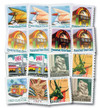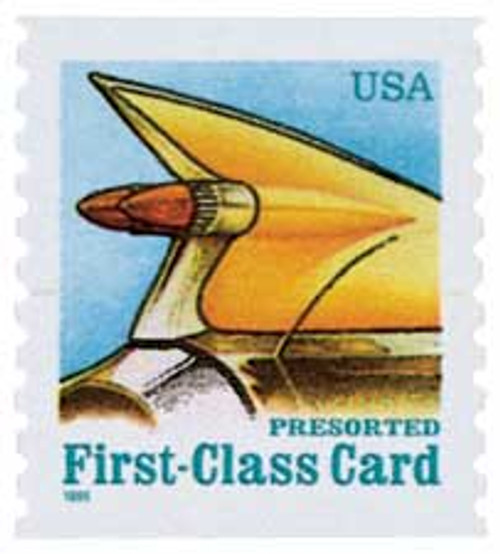
# 2908//3770 - 1995-2003 American Culture, set of 16 stamps
US #2908//3770
1995-2003 American Culture
- Set of 16
- Covered Bulk Rates
- Featured uniquely American popular culture
Category of Stamp: Definitive
Set: American Culture
Reason the stamps were issued: The stamps in the American Culture series were intended for use by bulk mailers of postcards.
This set includes:
#2908 – 1995 Auto Tail Fin, 15¢
#2909 – 1995 Auto Tail Fin, 15¢
#2910 – 1996 Auto Tail Fin, 15¢
#2911 – 1995 Juke Box, 25¢
#2912 – 1995 Juke Box, 25¢
#2912A – 1996 Juke Box, 25¢
#2912B – 1997 Juke Box, 25¢
#3132 – 1997 Juke Box, 25¢
#3208 – 1998 Diner, 25¢
#3208A – 1998 Diner, 25¢
#3447 – 2000 New York Library Lion, 10¢
#3520 – 2001 Atlas Statue, 10¢
#3522- 2001 Woody Wagon, 15¢
#3766 – 2003 Wisdom, $1
#3769 – 2003 New York Library Lion, 10¢
#3770 – 2003 Atlas Statue, 10¢
About the American Culture series: Three new definitive coil series were introduced in 1995: “American Scenes,” “American Transportation,” and “American Culture.”
The American Culture series shows items of our nation’s popular culture. The art director for the series, Carl Herrman, said, “The series tries to take a look at American creativity and at things that no other country could claim.”
The 15¢ Automobile Tail Fin stamp features the fin of a 1959 Cadillac, and was used for presorted first-class postcards. The 25¢ Juke Box coil stamp was intended for presorted first-class letters.
The 25¢ Diner stamp was issued in 1998. It pictures a typical restaurant popular in the middle of the 20th century.
In 2000, the New York Public Library Lions stamp was issued. The image is a contemporary rendition of one of the statues located at the Fifth Avenue entrance to the Library.
The Woody Wagon stamp design is based on the wood-paneled vehicles produced between 1929 and 1953 and used variously to transport guests to and from railroad stations, to accommodate family travel, and to carry surfers and their surfboards to the beach. The stamp pictures a 1949 Ford wagon with a surfboard hanging out the back.
The 10¢ Atlas stamp is based on a photograph by Horst Hamann of the Atlas Statue that stands outside Rockefeller Center in New York City. Lee Lawrie created the Atlas sculpture in 1937, and Kenneth Lynch made the skeletal, heavenly spheres that Atlas supports.
The design for the Wisdom stamp in the American Culture Series was taken from Lee Lawrie's art deco sculpture, "Wisdom With Light and Sound," at Rockefeller Center in New York City. Words beneath the relief sculpture are from Isaiah 33:6 in the Old Testament: "Wisdom and knowledge shall be the stability of thy time." The Wisdom stamp is the only issue in the American Culture Series that is not a coil stamp.
US #2908//3770
1995-2003 American Culture
- Set of 16
- Covered Bulk Rates
- Featured uniquely American popular culture
Category of Stamp: Definitive
Set: American Culture
Reason the stamps were issued: The stamps in the American Culture series were intended for use by bulk mailers of postcards.
This set includes:
#2908 – 1995 Auto Tail Fin, 15¢
#2909 – 1995 Auto Tail Fin, 15¢
#2910 – 1996 Auto Tail Fin, 15¢
#2911 – 1995 Juke Box, 25¢
#2912 – 1995 Juke Box, 25¢
#2912A – 1996 Juke Box, 25¢
#2912B – 1997 Juke Box, 25¢
#3132 – 1997 Juke Box, 25¢
#3208 – 1998 Diner, 25¢
#3208A – 1998 Diner, 25¢
#3447 – 2000 New York Library Lion, 10¢
#3520 – 2001 Atlas Statue, 10¢
#3522- 2001 Woody Wagon, 15¢
#3766 – 2003 Wisdom, $1
#3769 – 2003 New York Library Lion, 10¢
#3770 – 2003 Atlas Statue, 10¢
About the American Culture series: Three new definitive coil series were introduced in 1995: “American Scenes,” “American Transportation,” and “American Culture.”
The American Culture series shows items of our nation’s popular culture. The art director for the series, Carl Herrman, said, “The series tries to take a look at American creativity and at things that no other country could claim.”
The 15¢ Automobile Tail Fin stamp features the fin of a 1959 Cadillac, and was used for presorted first-class postcards. The 25¢ Juke Box coil stamp was intended for presorted first-class letters.
The 25¢ Diner stamp was issued in 1998. It pictures a typical restaurant popular in the middle of the 20th century.
In 2000, the New York Public Library Lions stamp was issued. The image is a contemporary rendition of one of the statues located at the Fifth Avenue entrance to the Library.
The Woody Wagon stamp design is based on the wood-paneled vehicles produced between 1929 and 1953 and used variously to transport guests to and from railroad stations, to accommodate family travel, and to carry surfers and their surfboards to the beach. The stamp pictures a 1949 Ford wagon with a surfboard hanging out the back.
The 10¢ Atlas stamp is based on a photograph by Horst Hamann of the Atlas Statue that stands outside Rockefeller Center in New York City. Lee Lawrie created the Atlas sculpture in 1937, and Kenneth Lynch made the skeletal, heavenly spheres that Atlas supports.
The design for the Wisdom stamp in the American Culture Series was taken from Lee Lawrie's art deco sculpture, "Wisdom With Light and Sound," at Rockefeller Center in New York City. Words beneath the relief sculpture are from Isaiah 33:6 in the Old Testament: "Wisdom and knowledge shall be the stability of thy time." The Wisdom stamp is the only issue in the American Culture Series that is not a coil stamp.















